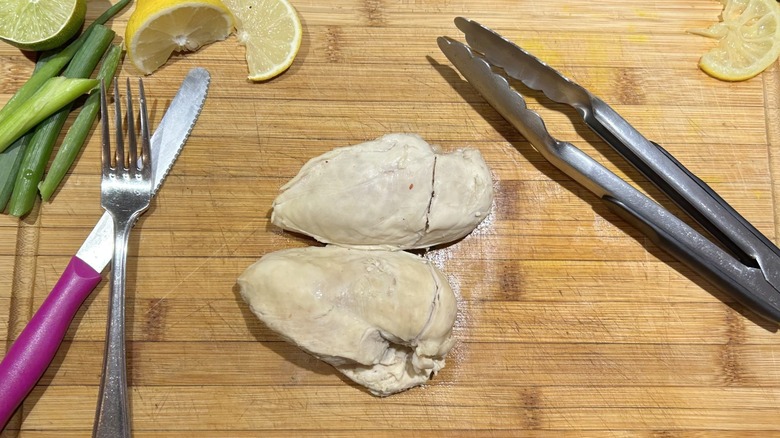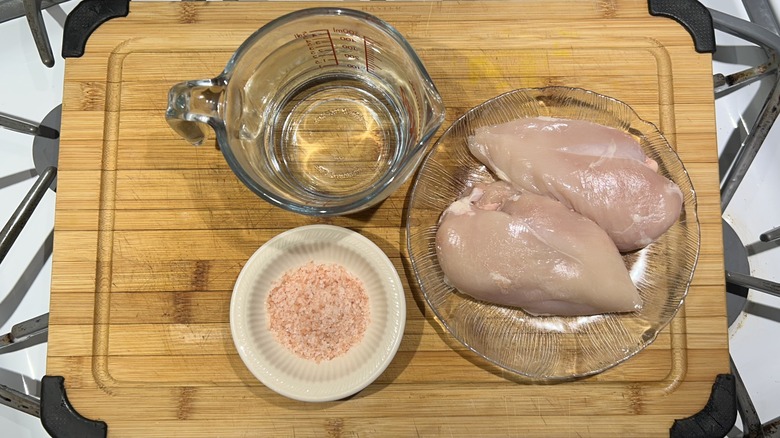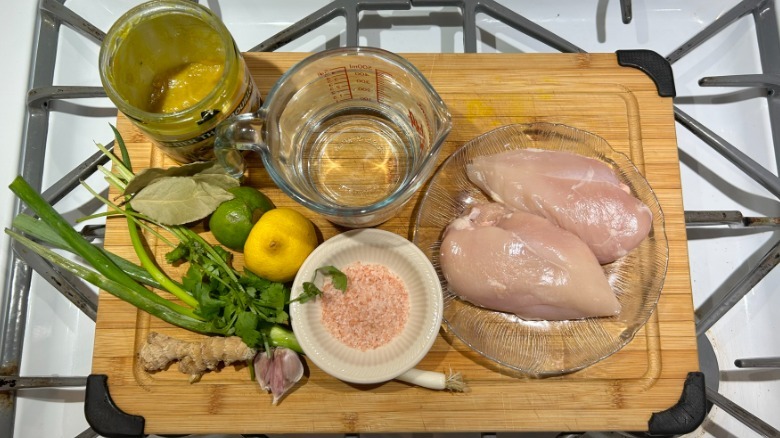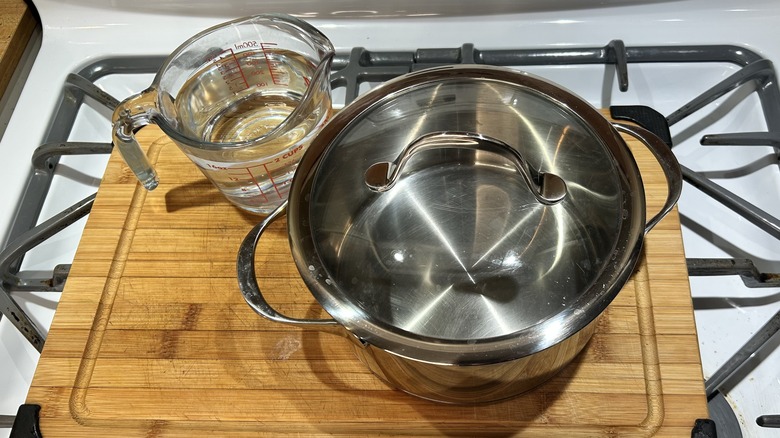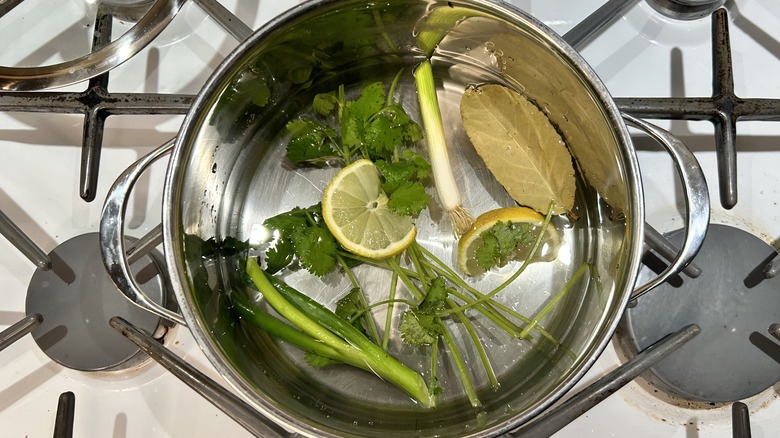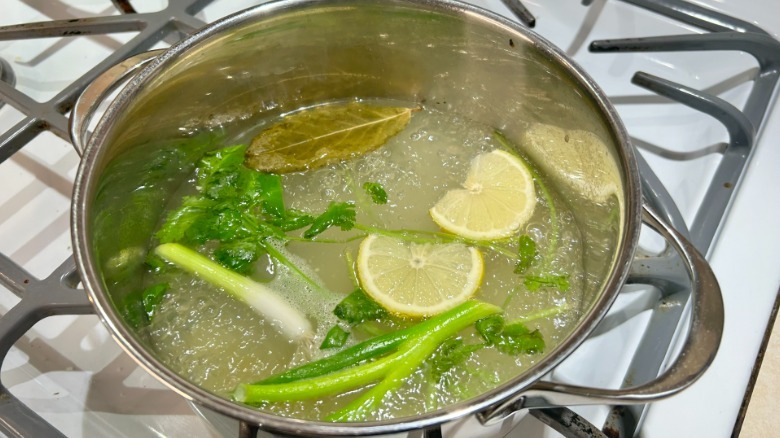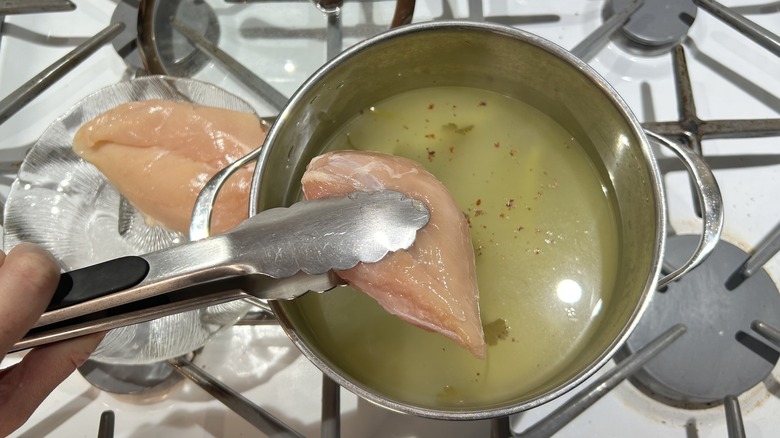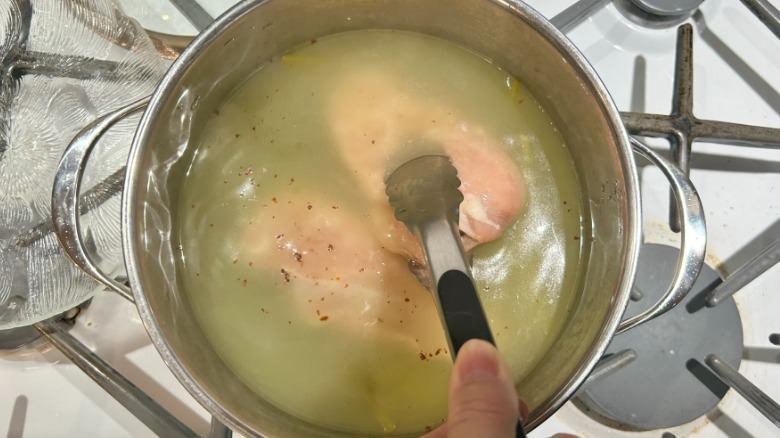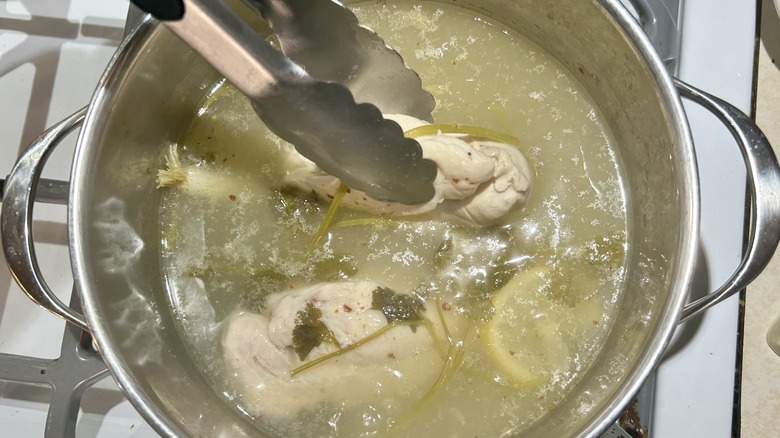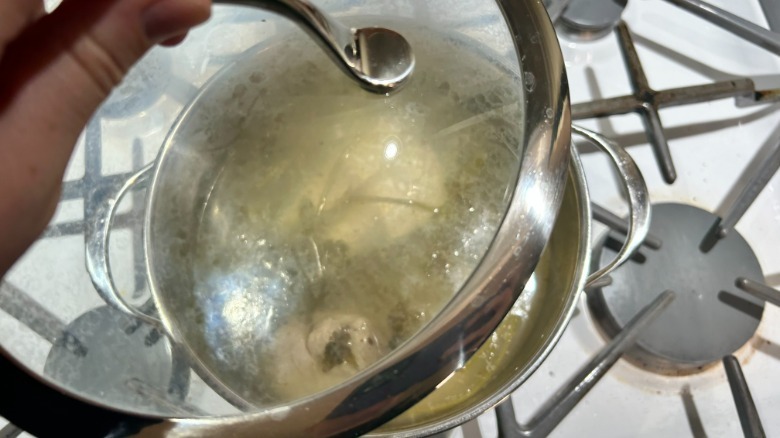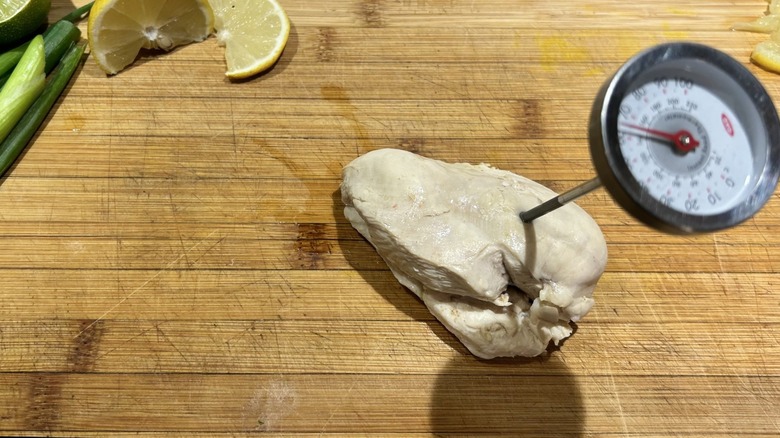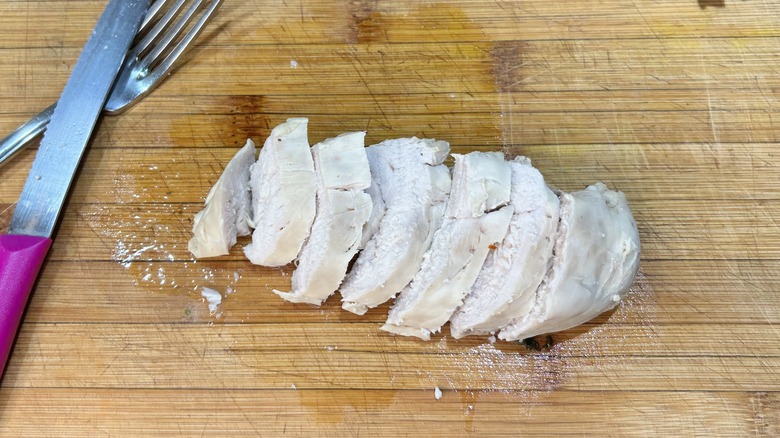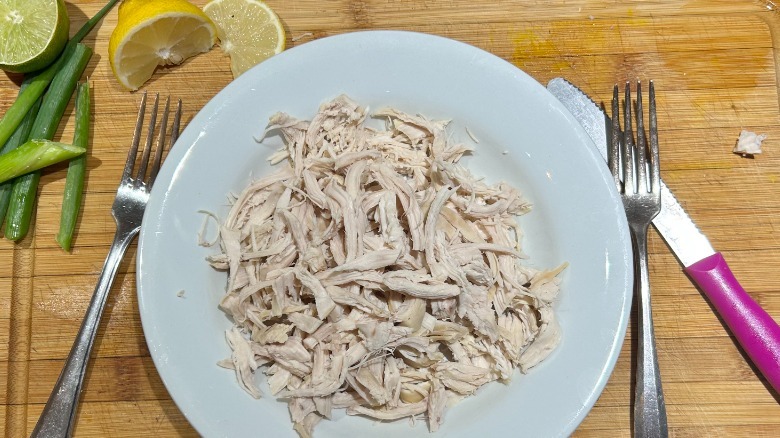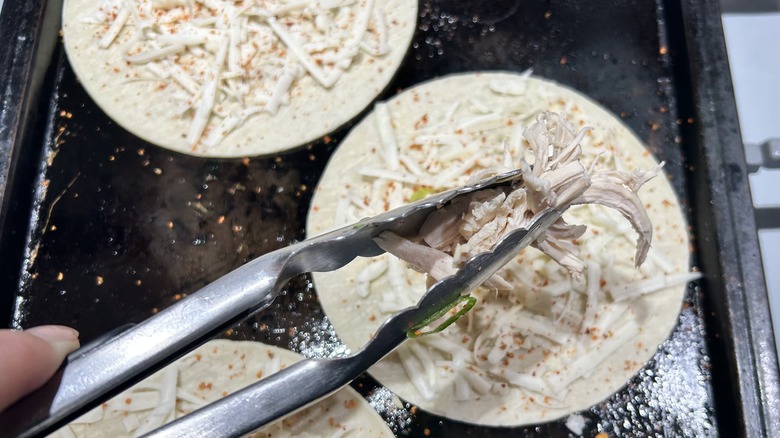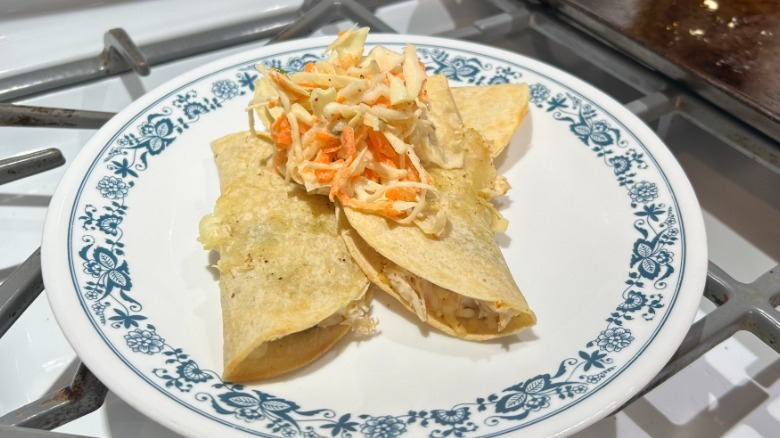How To Easily Poach Chicken So It Tastes Good
If you're looking for a simple, healthy way to prepare chicken, you might want to give poaching a try. Poaching is a cooking method that involves gently cooking with water. It's not the same as boiling, and when done correctly should yield more tender results. There's no butter or oil required.
You might associate poaching primarily with eggs. And if you've tried cooking poached eggs to disastrous effect, you may be disinclined to give this method a chance with other foods. But rest assured, poaching is pretty much as simple as it gets, and poaching chicken can actually be easier than poaching eggs! It's a quick, healthy method that should yield tender meat with minimal effort.
You can poach chicken for various recipes, and it's a great option when meal prepping for the week. Sliced or shredded poached chicken can be a go-to protein for everything from casseroles and tacos, to soups, salads, and sandwiches. There are several different methods, so feel free to try them all. You can even check out Andrew Zimmerman's tips for easy poached chicken. But here's one way that works well, so let's break it down!
Ingredients you'll need
To poach chicken, you'll need a few boneless, skinless pieces. We'll be using breasts here, but thighs work as well. And, in fact, you can use bone-in or skin-on pieces too if you like, but cook times may vary. The fat in the skin may even help keep the meat moist, but it definitely won't come out crispy, so you'll probably want to remove the skin before eating.
You'll also need enough liquid to submerge the pieces. The absolutely easiest way to poach chicken is simply with water and salt. But we recommend using broth and throwing in some extra aromatics for added flavor.
Equipment you'll need
To poach effectively, you'll want a pot or deep skillet with a tight-fitting lid. You can use anything as long as it's big enough for the pieces of meat to sit side by side without stacking. It is helpful (although not totally necessary) to have a meat thermometer. Poultry is dangerous to consume when undercooked, but you also want to avoid drying the meat out. Checking the internal temperature will remove any doubt and prevent undercooking and overcooking.
Season your broth (optional)
You can poach chicken in many different liquids, including chicken broth, vegetable broth, or even wine. If you don't have broth, you can also season the water with spices, vegetables, and herbs. If you know what kind of dish you'll be making with the chicken you can throw in some extra aromatics that go with that flavor profile. A few peppercorns, bay leaves, cloves of garlic, and onion will hardly ever go amiss. Chilies or chipotle peppers might be excellent additions if you're going to make pulled chicken nachos or enchiladas. A knob of ginger root or a few cardamom or star anise pods could be perfect if you're making Asian dishes.
In any case, if you have the time, you'll want to season the broth by simmering your aromatics before adding chicken. It will only take a few minutes to infuse the flavors into the water or broth.
The only tricky thing about this step is that many recipes recommend poaching your chicken by placing it into cold or room temperature liquid and bringing them up to temperature together to avoid toughening the meat on the outside while the center cooks. You can let your broth cool down again before adding the meat, but as long as it's not boiling hot, the method should still work. Note that if you're working with boxed broth or bouillon, you can skip this step because they will already be seasoned.
Add the chicken to your cooking liquid
Take the chicken out of the refrigerator about half an hour before you plan to cook it and let it come to room temperature. Then place the chicken pieces into the broth or water in one layer. If you're using plain water, this is when you add salt. Some recipes call for up to three whole tablespoons of salt to ensure the chicken is well seasoned. Other recipes caution that the addition of salt will alter the boiling point of the water and change the eventual cook time. Again, this is where the meat thermometer can come in handy.
Turn the burner on medium and bring the broth to a simmer. This will take a few minutes.
Remove chicken from the heat
When the water comes to a rolling simmer, flip the breasts over, cover the pot with the lid, and remove it from the heat. The chicken will continue to cook in the hot water until done — about another 5-10 minutes, depending on the size of the pieces. You can check them with the meat thermometer if you think they're done.
Let the chicken rest
Poultry should reach an internal temperature of 165 degrees Fahrenheit, but you can remove the meat five to ten degrees sooner and let it finish through carry-over cooking. Once you remove it from the heat it will continue to cook a little while resting. Letting the meat rest will also help to seal in the juices.
Slice or shred the chicken
Poached chicken should be tender and juicy. You can slice it and serve it as is, with a sauce, or shred it. If it's been poached right, the meat should shred easily. You can use a fork (or two forks) to shred the meat, or you can try shredding with this KitchenAid attachment.
Shredded chicken can last three to four days in the fridge when stored in an airtight container.
Cooking with poached chicken
Poached chicken is a super versatile ingredient. Shredded poached chicken is ideal for making chicken salad (or a green salad with chicken!), sandwiches, soups, casseroles, noodle bowls, and many other dishes. Try adding shredded poached chicken to your next pho or homemade chicken soup. It's also perfect for quesadillas and tacos, a tray of loaded chicken nachos, or enchilada soup for a warm, cozy alternative.
You can serve sliced poached chicken with anything, but it's especially tasty over rice or vermicelli with fresh herbs, sliced cucumbers, and a tangy vinaigrette made with citrus, soy, and fish sauce.
